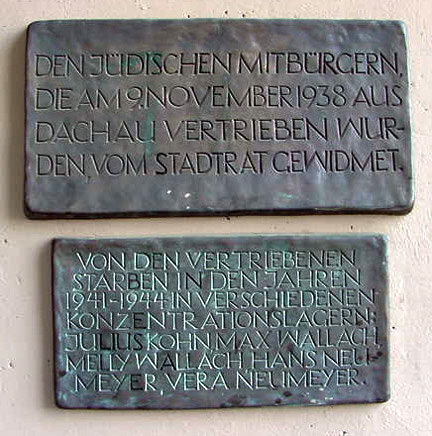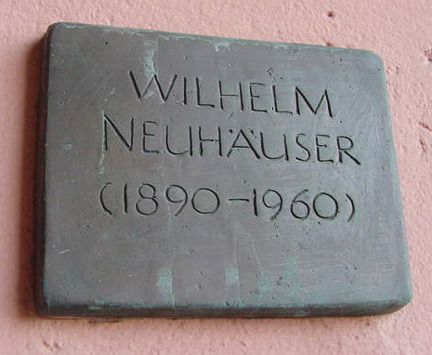Passageway thru new town hall The new town hall has a passageway through it to a veranda behind the building. In the passageway are several commemorative plaques and works of art. The photograph above shows the tables of the nearby Zieglerbräu Brewery and Inn on the veranda and a sculpture of a man done by Dachau artist Walter von Ruckteschell. There is a matching statue of a woman that is not shown here. The walls of the new town hall have mirrored windows and the photograph below shows the reflection of the same statue in the mirror on the opposite side of the passageway. In the photograph below, you can see a modern sculpture on the wall and the reflection of two plaques in honor of the Dachau's former Jewish residents which are shown in the third photograph below. The veranda behind the new town hall overlooks the Lower Town.  Also in the passageway through the new town hall are two plaques on the wall in commemoration of the Jews of Dachau who died in the Holocaust. The first plaque, shown in the photograph below, refers to Kristallnacht, the Nazi pogrom against the Jews which started on the night of November 9, 1938. This was a state-sanctioned riot in which the windows of all the Jewish stores in every city in Germany and Austria were smashed. Police stood by to prevent looting, but merchandise was thrown into the street and destroyed. Every synagogue was set on fire; the fire department extinguished the fires only if other nearby buildings were threatened. A total of 91 people lost their lives. This travesty took place after a three-day death watch over Ernst vom Rath, a diplomat at the German embassy in Paris who was shot by Herschel Grynzspan, a 17-year old Polish Jew. Herschel had fled to Paris when the Nazis announced in October 1938 that all Polish Jews in Germany would be deported back to Poland. The Polish government had already torn up their passports when they evicted them earlier and they would not allow them back into the country. Grynzspan's parents and sister were forced to live in a refugee camp on the border; his motive for killing vom Rath was to call the attention of the world to the plight of these stateless Jews. Although there was no rioting in the town of Dachau, and Dachau had no synagogue that could be burned, all 12 Jewish residents in the town were visited by Nazi officials on the night of November 10, 1938 and ordered to leave town before sunrise or risk imprisonment in a concentration camp. In the following days, there were 30,000 Jews throughout Germany and Austria who were rounded up and taken to the three major concentration camps, including 10,911 who were incarcerated in the Dachau camp. The second plaque gives the names of 5 of the 12 Jews of Dachau who later died in the Nazi death camps. The names, which are inscribed on the plaque shown below are Julius Kohn, Max Wallach, Melly Wallach, Hans Neumeyer, and Vera Neumeyer. One other Jewish resident whose name was on the list of Jews to be expelled was Alice Jaffe who had already moved from Dachau the year before. She also died in the Holocaust but her place of death is unknown. Julius Kohn and the Wallachs went to Berlin after they were expelled. They were later sent to Auschwitz where they were murdered. Hans Neumeyer died in the Theresienstadt ghetto in what is now the Czech Republic; his wife's place of death is unknown.  On the wall where the sculptures stand is a plaque in honor of Dachau artist Carl Thiemann who was famous for his wood carvings. Another plaque in honor of Wilhelm Neuhäuser is shown in the photograph below. Neuhäuser did the sculpture of Constantin Höfler which stands on the building next to the Obere Apotheke and a sculpture in the passageway.  Parish Church of St. JakobBack to List of Historic PlacesBack to Table of ContentsHome |